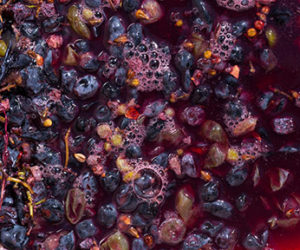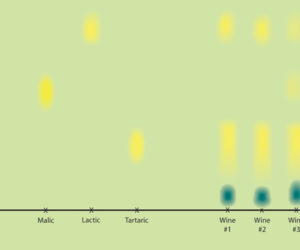Positive affects of oxidation? How can that be? Wine-makers know that oxygen negatively affects wine. A little oxygen, however, can actually be beneficial to your homemade wine.
Two common winemaking practices that have a positive influence are macroaeration and microoxygenation. Both are used in making some of the best reds and whites, evidenced by the rows and stacks of oak barrels in commercial wineries.
Macroaeration refers to the practice of aerating, or oxygenating, fermenting wine by vigorous racking to produce a softer, less astringent wine that exhibits more fruit character and improved color stability.
Microoxygenation refers to the controlled process of oak-barrel aging where wine is allowed to interact very slowly with air penetrating through the barrel. Apart from the flavors and tannins imparted by the wood, wines aged in oak barrels will exhibit more complexity than wines aged in stainless tanks or glass containers primarily because of microoxygenation.
Oxidation Reviewed
Oxidation is the result of wine being exposed to air during winemaking, at any time from grape or juice handling to bottling. Oxidation can also result from an inadequate sulfiting regimen. The more technical explanation is that free oxygen in air causes an enzymatic reaction with oxidases such as tyrosinase (poly-phenoloxidase) in grape juice resulting in the oxidation of the aromatic and pigmentation compounds.
Macroaeration
Macroaeration is only used in red winemaking as it involves vigorous splashing of wine during pump-over or racking operations. Macroaeration has a softening effect on the astringent tannins and enables the winemaker to produce a softer wine.
Wine aerated in this way is approachable much earlier (younger) and has well stabilized color. The higher phenolic content in reds affords them greater protection from negative oxidation effects compared to whites, which have considerably lower tannin content. Macroaeration therefore is never practiced and not recommended for white winemaking.
Macroaeration can also benefit red winemaking by providing yeast cells with oxygen and ensuring a healthy fermentation. Yeast require oxygen in order to thrive and to convert sugar into alcohol. If oxygen is not sufficiently available, yeasts can become inhibited and a stuck fermentation can result.
Another benefit is reduced hydrogen sulfide (H2S) production. A common cause of H2S in wines, detected as a rotten-egg smell, is vinification from grapes that have been over-treated with sulfur-based vineyard mildew and fungus inhibitors. Red wines made from grapes are more prone to H2S problems because the juice is allowed to macerate with the grape skins (therefore dissolving sulfite into the juice).
In white wines from grapes, it is not a problem because the juice is not macerated with the skins. Abundantly aerating the wine by racking it against the wall of the container will reduce the amount of potentially harmful H2S. If not treated early, H2S will react in the wine to form first into mercaptans followed by disulfides — both are foul-smelling compounds that cause wine to spoil. The presence of either compound is practically irreversible in home winemaking.
Macroaerating Wine
There are several ways to macro-aerate wine, each having a varying degree of effectiveness. These fall into two main categories: splashing wine and injecting oxygen into wine.
The most common method of splashing used by home winemakers is quite simple — just let the wine splash against the wall of a carboy during racking. Commercial wineries often use delestage fermentation, also known as the rack-and-return method. This method involves fermenting wine that is racked by gravity and flows into a vat, then returned to the tank with a pump. Refer to “Do the Delestage” in the June–July 2003 issue of WineMaker for more information on delestage fermentation.
Although these techniques are proven, some industry experts argue that the wine is still too protected by the layer of carbon dioxide gas that is forming over the wine volume during racking, and therefore the wine does not absorb sufficient air to benefit from macroaeration. It is winemakers of this opinion that turn to the method of injecting oxygen into the wine.
Commercial wineries connect a venturi attachment to their hose when returning wine to the top of the tank during the pump-over operation. The venturi attachment is a simple inverted T-connector that allows air
to be drawn into the wine stream when the wine is being pumped over. A check valve may also be used to prevent backflow.
A home winemaker can easily make a T-connector using polyethylene tubing and plastic barb adapters. The T-connector can then be inserted into the racking line by cutting the tube midway and connecting each end to the barb adapter. You will need to test with various lengths of tube on the leg side of the T until the “burping” stops during racking. Alternatively, if you use a pump with a valve on the suction side for pump-over, be sure to open this valve when working the pump.
And remember — do not aerate wine during malolactic fermentation (MLF). ML bacteria are usually very sensitive to oxygen and can become inhibited, which will commonly result in a stuck MLF.
Microoxygenation
A miniscule, controlled amount of oxygen during wine aging can be beneficial for wine to develop and show its full potential. It allows wine to develop and age gracefully while softening tannins, stabilizing phenols and increasing flavor complexity — a phenomenon known as microoxidation, or microoxygenation. This cannot happen in air-tight, inert containers such as stainless steel tanks or glass carboys.
Until recently, microoxygenation mainly occurred during barrel and bottle aging where wine breathes through the wood and head and stave joints (the tight space between the pieces of wood forming the heads and walls of a barrel). Wine can also breathe through the cork during the aging process.
New advances in winemaking technology however, now make it possible to microoxygenate wine in controlled fashion at any stage of the process, such as tank aging, for example, and replicate the benefits of barrel-aged wines, albeit in a much shorter time period.
Microoxygenating Wine
When barrel-aging wine, no special microoxygenation equipment or process is required; the barrel does all the work. The winemaker only has two tasks: The first is to check the wine level every three to four weeks to ensure that everything is developing as planned according to your desired taste. The second is to do is top up the barrel. This will avoid “bad” oxidation, offensive smells and unfavorable tastes in your wine.
For bottle-aging wine, natural or agglomerated corks are recommended. Some winemakers maintain that screw caps and synthetic corks provide too much of an airtight seal depriving the wine of the microoxygen that is necessary for it to evolve gracefully. The argument is that airtight seals inhibit microoxygenation and completely stifle the type of evolution required in well-aged wines. If a winemaker prefers to drink young wine, screw caps or synthetic cork closures are certainly a convenient method.
Keep Oxidation in Check
If done correctly, home winemakers can develop a means of letting oxygen work for them as opposed to against them and their wines. However, don’t forget about the negative effects of oxidation that discussed in the last article. Oxidized wine becomes devoid of fruity aromas and will spoil and need to be discarded if not treated. This can be discouraging for a beginning winemaker, so beware!







